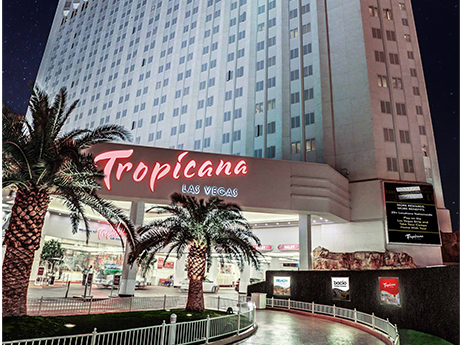LAS VEGAS — The Oakland Athletics have reached an agreement with global casino entertainment company Bally’s Corp. (NYSE: BALY) and Gaming & Leisure Properties Inc. (GLPI) for a nine-acre development site on the 35-acre Tropicana Las Vegas campus. The A’s hope to develop a 30,000-seat ballpark at the site, which is situated along the Las Vegas Strip on Las Vegas Boulevard and Tropicana Avenue.
“We are excited about the potential to bring Major League Baseball to this iconic location,” says Dave Kaval, president of the Oakland A’s. “We are thrilled to work alongside Bally’s and GLPI and look forward to finalizing plans to bring the Athletics to Southern Nevada.”
Yahoo! Sports is reporting that the baseball club is requesting $395 million in public funds to go toward the estimated $1.5 billion project. The deal is subject to approval by the Nevada Legislature, which could meet to approve funds as early as this week. The project is also dependent on Major League Baseball’s approval of the team’s relocation from Oakland, Calif.
Bally’s acquired the building and operations of the Tropicana Las Vegas from GLPI in September 2022 as part of a $148 million transaction. As part of the deal structure, Bally’s entered into a 50-year ground lease with GLPI with the ability to extend to 99 years upon achieving key investment milestones.
GLPI has agreed to fund up to $175 million toward shared improvements within the future ballpark in exchange for a “commensurate rent increase” with the A’s.
“We are pleased to help facilitate [the A’s] exciting vision for a new ballpark through our contribution of nine acres of the Tropicana site and look forward to the prominent place that the overall project will occupy in the Las Vegas skyline,” says Peter Carlino, chairman and CEO of GLPI. “As the project moves forward, we also expect that GLPI will have opportunities to further invest in the various aspects of the overall project.”
Bally’s intends to continue the operations of the Tropicana Las Vegas for the foreseeable future while evaluating options for a broader redevelopment of the remainder of the site that will be adjacent to the new ballpark.
The A’s expect to welcome more than 2.5 million fans and visitors annually at the new stadium upon completion. Construction timelines were not released, but the team reportedly has the option to develop in phases.
Kaval has previously stated he hopes to break ground on a Las Vegas ballpark next year and open in time for the 2027 season. The team’s current lease at the Oakland Coliseum expires next year.
About a month ago, the A’s signed a purchase agreement with Red Rock Resorts for 49 acres near the Las Vegas Strip. The new deal is a scaled-back version of the now-void Red Rock project. While the Tropicana site ballpark won’t immediately feature a surrounding mixed-use village, it will be closer to popular hotels including MGM Grand and Mandalay Bay.
The A’s have made strides to stay in the Bay Area the past several years but the team has zeroed in on Las Vegas as its new home over the past few months. Rob Manfred, commissioner of Major League Baseball, reportedly told baseball owners and executives at the league’s winter meetings that the door was closed on Oakland keeping the A’s and that the league would waive the team’s relocation fee, according to CBS News.
GLPI invests and finances real estate property to be leased to gaming operators in triple-net lease arrangements. The REIT is based in Wyomissing, Pa.
Bally’s is a global casino-entertainment company that owns and manages 15 casinos across 10 states, not including previously announced casinos in Chicago and State College, Pa.
The company’s stock price closed on Monday, May 15 at $15.67 per share, down from $24.27 a year ago, a 35.4 percent decrease.
Founded in 1901, the A’s have nine World Series titles and 15 American League Pennants. The team relocated from Kansas City to Oakland in 1968. Currently, the team is in last place in the American League West division with a record of 9-34, a .209 winning percentage, the worst in Major League Baseball.
— John Nelson


